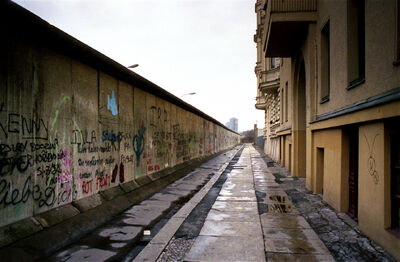- Koepenicker Strasse runs parallel to the Spree, and hence the Berlin Wall. It runs from Heinrich-Heine Strasse to the Oberbaumbruecke, both of which are crossings to the GDR. The section of the Berlin Wall here is built extremely close to buildings, sometimes with nothing but a gutter running in between. On this street are buildings from the Grunderzeit era—residential buildings, factories and various businesses—that have been heavily damaged by the war. The residents have taken up to covering the Wall with graffiti, expressing their general sentiment of bleakness and dysphoria.
Heinrich-Heine Strasse[]
Heinrich-Heine Strasse forms an intersection with Koepenicker Strasse. On this street is a lesser known checkpoint, used for civilians and West German citizens to cross over the East. Barbed wire and white cement road blocks mark the beginning of the crossing. Guard booths on the side of the road house border guards who check the papers of those driving through. This checkpoint is also where goods and postal transport between the two halves of the city were inspected. A plaque on the West side commemorates those who have lost their lives attempting to cross the border.
Rauch-Haus[]
- The site of the old Bethanien Hospital has been taken over by alternative, pro-leftist squatters, who call it “Rauch-Haus”, after left-wing radical Georg von Rauch, who was killed after an altercation with police in 1961. After a few police raids which has failed to root the squatters out, the city of Berlin in 1971 extended them a provisional contract for use of the building. There has been a few more police raids from ’71 to ’75, but for now, the site is occupied, inhabited by 40 to 50 young people who do not plan on leaving any time soon.
- The hospital is a looming, grey brick building that has fallen to disrepair. The occupiers had spray-painted the ground floor wall full of left-leaning and anarchist scribbles. “Kick Schmidt and Press and Mosch out of Kreuzberg...This is OUR house.” This place welcomes people seeking shelter as long as they abide by the rules of the commune—to care and live together and to not live at the expense of others. They also hold demonstrations and distribute leaflets to spread the word, to draw hippies, runaways, and politically-minded youths to their commune. The compound is lively and people come and go at all hours of the night; this is frequently a source of noise complaints by the neighbours.
| Site: Rauch-Haus |
|---|
|
Skills: Larceny ••, Streetwise •• Controller: n/a Merits: n/a Cornerstone: Counterculture |
Oberbaum Bridge[]
The Oberbaumbruecke is a double-deck bridge crossing the River Spree, leading to the Friedrichschain district in East Berlin. The bridge has a distinctive appearance of two “Brick Gothic” style towers, and the whole exterior of the bridge was constructed red brick. The bridge had been closed to regular traffic since the construction of the Wall. A pedestrian crossing is available for West Berlin residents only. There is usually a short queue by the footpath where East German border guards check the visa of citizens before they're allowed to cross.
East Berlin-Friedrichshain[]
The Oberbaumbruecke stands between you and West Berlin. You can see the River Spree on this side of the Wall, long and winding, with a 14-foot tall concrete wall erected on the other bank. Friedrichshain is a focus of new development for the East Berlin government. You can stroll down Stalinallee (newly-renamed Karl-Marx-Allee), which resembles a broad, Soviet-era Moscow boulevard with its grandiose architecture and “worker's palaces”. East Germany's largest cinema, Kosmos, is also located here.
U-Bahnhof Schlesisches Tor[]
The design is from 1902 and quite grand for a subway station. The exterior features red brick with white border stones, white arches and arched windows, and a turret with a domed roof. This is the last station for the U-bahn in West Berlin.





